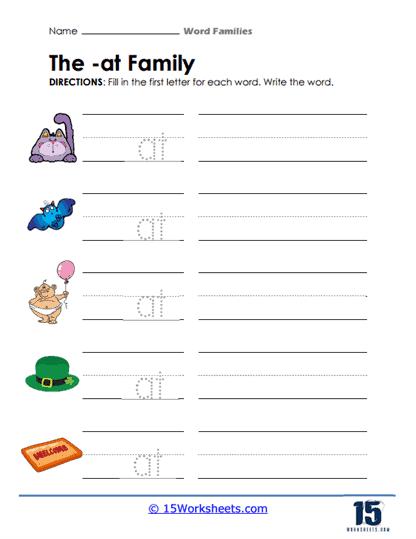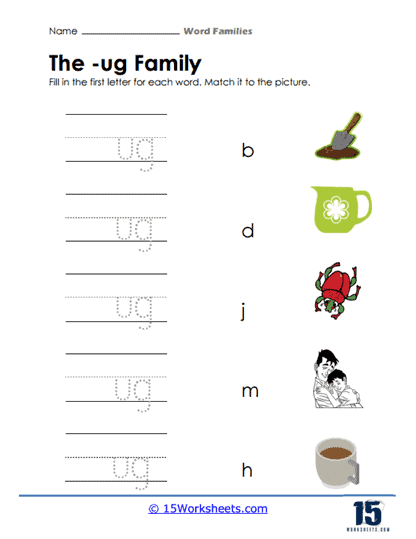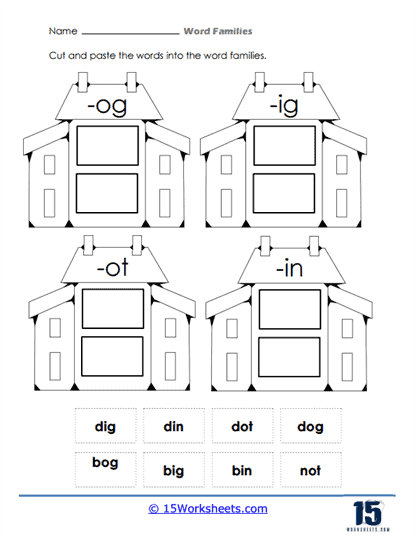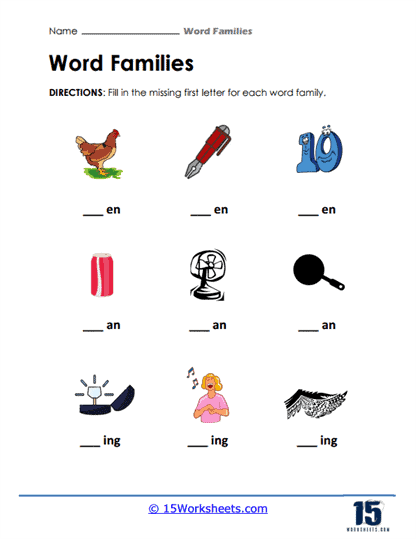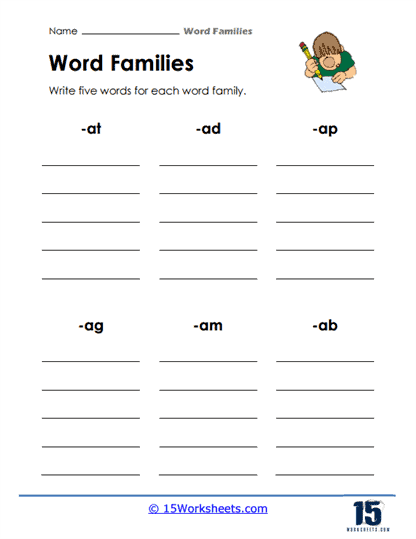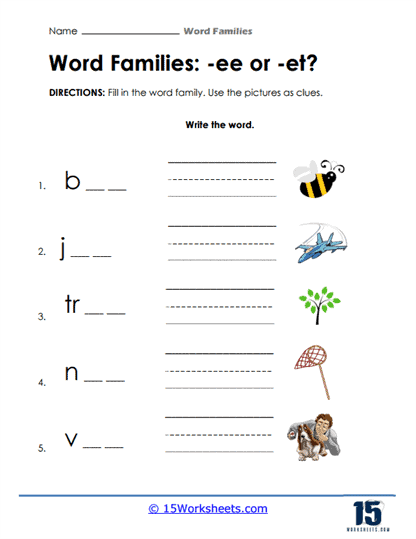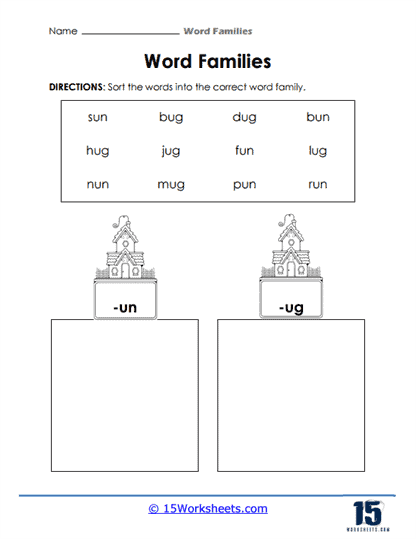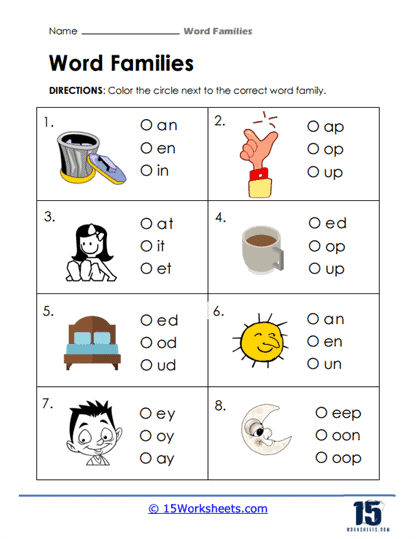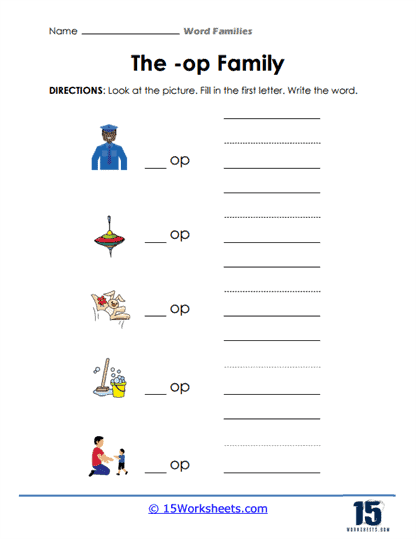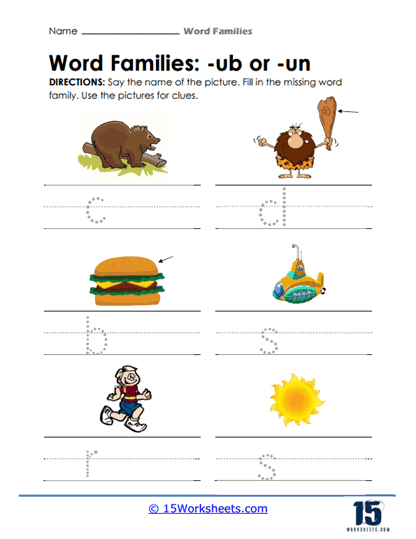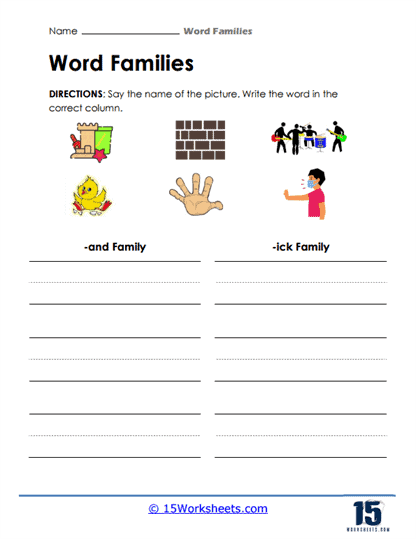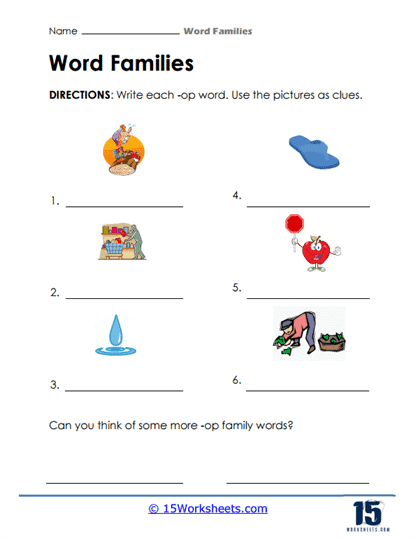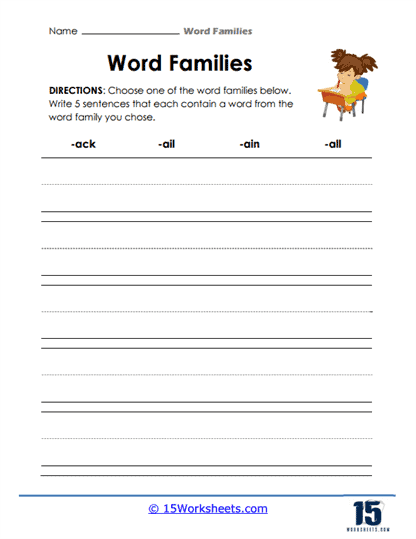Word Families Worksheets
All About These 15 Worksheets
Word families are the cornerstone of early literacy and phonics education. These groups of words that share the same ending sound or chunk play a pivotal role in building reading and spelling skills. Understanding and mastering word families is essential for young learners as it equips them with the tools needed to decode words, expand their vocabulary, and develop reading fluency.
To empower students with the knowledge and practice required to excel in reading and spelling, we proudly present a collection of 15 worksheets titled “Word Families.” These worksheets are meticulously designed to provide students with structured and engaging opportunities to explore and understand the concept of word families.
What are Word Families Worksheets?
Word Families Worksheets are educational resources designed to help students practice and learn about word families, which are groups of words that share a common spelling pattern or phonetic sound. Examples of word families include “-at” words such as “cat”, “bat”, and “rat”, and “-ight” words such as “light”, “night”, and “sight”.
These worksheets often include various activities, such as matching, sorting, or writing exercises, that focus on identifying and distinguishing between words that belong to the same word family.
What Are Word Families?
Word families, also known as phonograms or rimes, are groups of words that share a common root or base word and have similar patterns in their spelling and pronunciation. These words typically have the same ending or a shared sequence of letters that correspond to a specific sound. Word families are used as a tool to teach reading, writing, and spelling by helping learners recognize patterns and make connections between related words.
For example, the word family based on the root “-at” includes words like “cat,” “hat,” “bat,” “rat,” and “mat.” All these words share the same “-at” ending and have a similar pronunciation.
Learning word families can be beneficial for language learners because:
- It helps improve reading and decoding skills by enabling learners to recognize and predict patterns in words.
- It aids in spelling, as students can learn to spell a group of words that share the same pattern more easily than learning each word individually.
- It enhances vocabulary and comprehension, as students can use their knowledge of word families to understand and make connections between related words.
Here is a list of some of the most common word families in the English language. These word families are often taught to beginning readers and can serve as a foundation for building vocabulary and developing reading skills:
- -at (cat, bat, rat, hat, mat)
- -an (man, pan, fan, ran, can)
- -ap (cap, map, lap, tap, nap)
- -ad (pad, mad, sad, glad, bad)
- -am (ram, ham, jam, clam, yam)
- -et (pet, wet, jet, met, net)
- -en (pen, hen, den, men, ten)
- -ed (bed, red, fed, led, wed)
- -eg (leg, peg, beg, keg, meg)
- -ig (big, pig, wig, dig, fig)
- -in (pin, win, sin, fin, kin)
- -ip (lip, zip, rip, dip, hip)
- -it (hit, bit, sit, kit, pit)
- -og (dog, log, fog, jog, hog)
- -op (hop, mop, pop, top, cop)
- -ot (hot, pot, dot, cot, lot)
- -ug (hug, bug, rug, jug, dug)
- -un (sun, run, fun, bun, gun)
- -ut (cut, hut, nut, rut, but)
By learning these common word families, students can develop their reading, spelling, and vocabulary skills more efficiently. Familiarity with word families allows learners to recognize and predict patterns in words, making it easier to decode and understand new words they encounter.
Teaching word families typically involves providing examples, engaging in activities like word sorting or word building, and incorporating word families into reading and writing exercises. By understanding and mastering word families, learners can improve their overall language skills and fluency.
Benefits Of Using Word Families worksheets
The “Exploring Word Families” worksheet collection offers numerous advantages for students:
- Structured Learning: The worksheets are thoughtfully organized to provide students with a structured learning experience. They progress from basic exercises to more complex tasks, ensuring students build a strong foundation in recognizing and using word families.
- Engaging Activities: Each worksheet incorporates fun and interactive activities, including word sorting, word searches, fill-in-the-blank tasks, and sentence completion. These activities make learning about word families enjoyable, keeping students motivated and interested.
- Versatility: These worksheets can be used in various educational settings, including classrooms, homeschooling, and tutoring sessions. They are adaptable to students of different ages and proficiency levels.
- Enhanced Confidence: As students work through the worksheets and successfully master word families, their confidence in their reading, spelling, and language skills will grow. This boost in self-esteem can positively impact their overall academic performance.
- Improved Literacy Skills: Proficiency in recognizing and using word families contributes to improved reading fluency, comprehension, spelling, and vocabulary development.
This collection of Word Families worksheets is a valuable resource for educators and parents committed to supporting their students’ phonics and literacy development. Proficiency in recognizing and using word families is a foundational skill that opens doors to reading fluency, comprehension, effective spelling, and vocabulary growth.
By using these engaging worksheets, students will strengthen their ability to explore and understand word families with confidence. This collection is an investment in their future success, ensuring they have a solid foundation in phonemic awareness, phonics, spelling, and vocabulary. Embrace the “Word Families” collection today, and watch your students excel in their journey toward becoming skilled and confident readers and writers.

